The week at a glance
- Belated report of a Great Spotted Cuckoo in Pembrokeshire
- Influx of early summer migrants
There were some glorious mid-March days this week, at times making it feel rather more like mid-May than the middle of the third month of the year. Clear blue skies, warming sunshine and light winds meant that the migrant door was finally forced open as early arrivals began to make landfall in southern England (although a little grot would have made it better still). Elsewhere, birds had a more wintry feel to them, but there was plenty for all to try and see.
There were no real headliners this week: some nice early spring arrivals yes, but birds of the very highest quality were, not surprisingly, lacking — it is, after all, still the middle of March. Top bird this week was actually seen last week: a brief first-summer Great Spotted Cuckoo noted at Trefeiddan Common (Pembrokeshire) on 10th became the second record of the species already this year (following on from the bird in Cork last month). If accepted, this bird will be a county first, and only the third for Wales (the two previous birds were noted in 1956 and 1960). It is also eight years since two Great Spotted Cuckoos have been seen in spring (both birds in 2001 were seen in March).
A White-billed Diver was seen again on Mull, at Loch na Keal, on 13th. A single Balearic Shearwater was noted off Portland Bill (Dorset) on 12th and a single Little Auk was seen from a boat in the Tresco Channel (Scilly) on 15th.
Plenty of Cattle Egrets were still up for grabs this week, with the southwest corners of England and Ireland holding the high numbers. On St. Mary's (Scilly) the rather cheeky singleton was still present to 16th at least. In Cornwall, nine birds remained around the Hayle Estuary to 17th, four birds were near Land's End during the week and another single lingered on the Gannel Estuary on 12th. A belated record was of a Cattle Egret at Morwenstow on 10th (which had been present for some three weeks before that). In Devon, four birds were seen around the Otter Estuary on 12th (and one remained there until 17th). Single birds were still at Powderham and at Yelland during the week. In Dorset, a Cattle Egret was at Swineham GPs on 18th while on the Isle of Wight the bird at Puckpool Point was present from 12th–16th, and in Suffolk the Cattle Egret was at Bures was still present to 18th. A bird near Frodsham (Cheshire) from 15th had actually been present since 8th. In Pembrokeshire, the Cattle Egret remained at Newport, on the Nevern Estuary, to 18th. In Ireland, six birds were at Rossleague on 15th–17th, four were at Ballyduff (Co.Waterford) and the same county hosted a single Cattle Egret at Quilla on 14th.
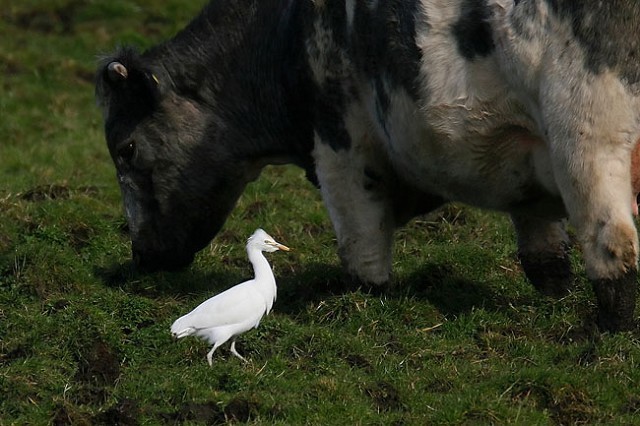
Cattle Egret, Bradley, Cheshire (Photo: R.L.Brown)
The Great White Egret at Gilmourton (Clyde) was present from 12th–15th and another was at Saltholme Pools (Cleveland) on 14th. On 16th, single Great White Egrets were at Dawlish Warren (Devon) and the Ouse Washes (Cambridgeshire), and on 17th–18th one was again at North Warren (Suffolk). Devon and Dorset had almost exclusive rights to Spoonbills this week: at least six birds were seen in the former county, at Wrafton, Bradiford Water, Isley Marsh (a colour-ringed juvenile on 15th) and Exminster Marshes, while the latter county saw one still at Lodmoor, at least three at Arne and six at Middlebere on 14th. In Wales, the single Spoonbill was still at the National Wetlands Centre (Carmarthenshire) to 15th. Fourteen Common Cranes roosted at Horsey (Norfolk) on 15th, while the same date saw two fly over the Waveney valley (Suffolk). On 13th, a Crane was seen at Crosby (Lancashire). An approachable White Stork (bearing a closed ring) was seen in Durham on 13th, with presumably the same bird noted again in the county two days later, moving to Northumberland on 16th. A bird with rather better credentials was seen flying over near Marazion (Cornwall) on 15th. The first Glossy Ibis of 2009 hit the record books this week when a single bird was seen at Tacumshin (Co. Wexford) on 13th (the most recent was of a bird, also at Tacumshin, on 27th December last year).
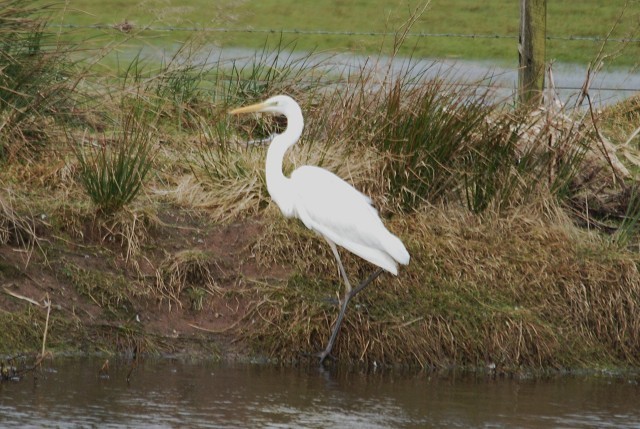
Great White Egret, Gilmourton, Clyde (Photo: Brian Henderson)

Spoonbill, Isley Marsh RSPB, Devon (Photo: Chris Cook)
There was no news and/or no sign of the Red-breasted Goose in West Sussex this week. On Islay, a Richardson's Canada Goose was at Loch Gruinart on 14th. Single, presumed vagrant, Snow Geese remained in Argyll, Ayrshire and County Mayo this week, while Black Brants included one or two birds each for Hampshire, West Sussex and Norfolk.
Lesser Scaup was holding steady on three birds this week: adult drakes at Holme Pierrepont (Nottinghamshire) and Lough Ennell (Co. Westmeath) and the first-winter drake remaining in Cardiff Bay (Glamorgan). England's only Ring-necked Ducks were drakes at Foxcote Reservoir (Buckinghamshire) to 14th and Frithend Sand Pits (Hampshire) to 17th, while Scotland was represented by single drakes on Loch an Eilein and Loch Bhasapol (both on Tiree), Asta Loch near Scalloway (Shetland) and Loch Calder (Highland), while single Scottish females were still on Martnaham Loch (Ayrshire) and North Ronaldsay (Orkney). In Wales, a drake was found at Llyn Mawr (Powys) on 15th (still present on the following three days) while the Four Nations clean sweep came with Irish birds at Vartry Reservoirs (Co. Wicklow), the two females there again on 12th–16th; a drake at Oxford Island NNR on 16th–17th; a drake on Lough Bo (Sligo) and a duck on Lough Arrow (Cork) on 17th; and a drake at Macroom and a duck on The Gearagh in the early part of the week. A drake Ferruginous Duck was seen at Loompit Lake (Suffolk) on 18th (along with a hybrid Ferruginous Duck x Pochard and six Garganeys). This last species arrived in some number this week and included 26 flying past Splash Point, Seaford (East Sussex) on 18th, a day when up to 70 were reported countrywide (although there may be some duplication along the Sussex coast).
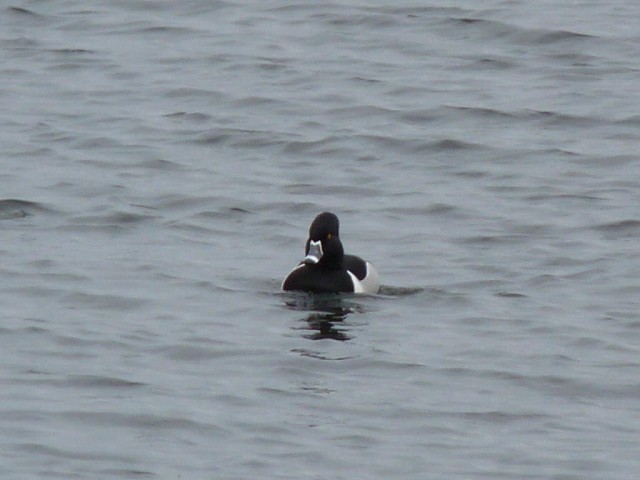
Ring-necked Duck, Oxford Island NNR, Armagh (Photo: Ed.O'Hara)

Ring-necked Duck, Frithend Sand Pit, Hants (Photo: Richard Ford)

Ferruginous Duck, Loompit Lake, Suffolk (Photo: Jon Evans)
Up to eleven Green-winged Teal were noted this week, with four of the five English records being of birds noted in recent weeks (in Leicestershire, East Yorkshire, Northumberland and Cleveland) while a new bird was at Mickle Mere (Suffolk) on 16th (at first suggested as a potential hybrid). In Scotland, the regular bird was still at Kinneil Lagoons (Forth) and last week's drake at Loch of Tankerness (Orkney) was still present to 13th. A new bird was at Baleshare, North Uist (Outer Hebrides) on 15th. In Ireland, single drakes were at Tacumshin (Co. Wexford), Cabragh Wetlands (Co. Tipperary), Lurgan Green (Co. Louth) and Kilcoole (Co. Wicklow). Just two American Wigeons were reported this week: the first-winter drake was still at Slimbridge (Gloucestershire) on 12th and again on 16th–18th, while the adult drake was still on Orkney, at Loch of Tankerness from 13th–14th.

Green-winged Teal, Mickle Mere, Suffolk (Photo:
Adi Sheppard)

Green-winged Teal, Bothal Pond, Northumbs (Photo: Mark Easterbrook)
There were two new Surf Scoters on the block this week! A second-winter drake was seen in Inganess Bay (Orkney) on 13th while the regular twosome, the drake at Ruddon's Point (Fife) and the duck off Dawlish Warren (Devon), were ever-presents, the former joined by a second drake on 17th. The two Irish King Eiders were still in the bays off Lissadell (Co. Sligo) to 17th and the second-winter drake was still off Kincraig Point (Fife) to 17th. The drake Hooded Merganser was still at Radipole Lake (Dorset) to 14th.
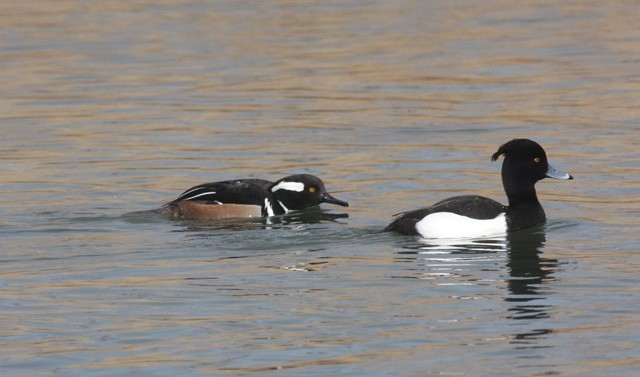
Hooded Merganser, Radipole Lake RSPB, Dorset (Photo: R McIntyre)
On Scilly, the young white Gyrfalcon was seen over St. Mary's again on 13th, while another white juvenile was seen around Annagh Head (Co. Mayo) on 15th and 17th. An immature White-tailed Eagle was reported flying high over Congleton (Cheshire) on 16th. Interestingly, a possible White-tailed Eagle had been seen flying southwest over Marton, in Lincolnshire, some two and a half hours before the Cheshire sighting, and with just 75 miles or so between the sites there is an tempting conclusion to be drawn. A released juvenile White-tailed Eagle was still at Loch of Strathbeg (Aberdeenshire) on 17th. Two Rough-legged Buzzards were still at Newbiggin Common (Co. Durham) early in the week, with another record in the county coming from Middleton-in-Teesdale on 15th. New birds were noted at Reydon (Suffolk) on 15th and at Marton Mere (Lancashire) on 16th, while regulars remained on the Hampshire/Berkshire border and also in Kent, Norfolk and Lincolnshire. The second Black Kite of the month was seen over the splendidly named Blubberhouses in North Yorkshire on 15th.
The adult Long-billed Dowitcher was seen again in Dundalk Docks (Co. Louth) on 15th and, as has often been the case recently, was the only shorebird of note this week.
The adult Bonaparte's Gull was still seen daily in Cardiff (Glamorgan) from 12th–17th at least, while the first-winter American Herring Gull on the Otter Estuary (Devon) was seen each afternoon between 13th and 16th. The adult smithsonianus remained in Galway to 15th at least.

Bonaparte's Gull, Cardiff Bay, Glamorgan (Photo: Chris Thomas)
The tip at Pitsea (Essex) produced three Caspian Gulls on 14th (a third-winter and two first-winters), while Suffolk's Minsmere RSPB reserve hosted three different birds during the week, a first-winter and two third-winters. Elsewhere, it was two birds each for Buckinghamshire, Oxfordshire and London, along with a further single for Essex, as well as loners in Kent, Norfolk, Warwickshire, Leicestershire and Staffordshire.
After a huge week last week, Iceland Gulls slumped markedly over the past seven days. Around 80 birds were noted in Britain, with around 50 in Ireland. Five birds were still at the Shetland Catch factory near Lerwick on 13th, while the highest count of the week was of 14 at Killybegs (Co. Donegal) on 14th, a total that included 10 juveniles. Numbers of Kumlien's Gulls also fell away this week: single juveniles were seen on Scilly and at Rainham Marshes (London), with the second-winter seen last week at Shawell (Leicestershire) remaining to 18th but also making appearances near Rugby (Warwickshire) on a couple of occasions during the week. Another second-winter bird lingered at Nimmo's Pier (Co. Galway), while two birds, a juvenile and third-winter, were still in the same county, at Clifden on 16th.
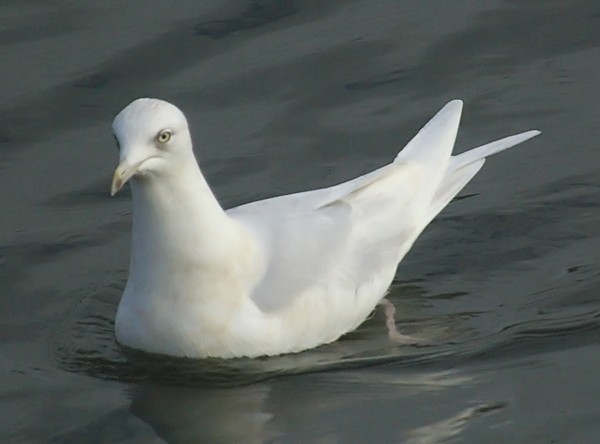
Iceland Gull, Killybegs, Donegal (Photo: Derek Charles)

Kumlien's Gull, Killybegs, Donegal (Photo: Derek Charles)
Glaucous Gull numbers also fell away this week. Around 55 birds were recorded in Britain, with five at Balranald (North Uist) on 12th and four at Marwick (Orkney) on 15th the highest totals noted. In Ireland, up to 30 birds were seen, including seven (six of them youngsters) at Killybegs on 14th.

Glaucous Gull, Scatness, Mainland, Shetland (Photo: Steve Minton)
Just as last week (and a few weeks before that as well), Ireland was firmly in charge of all things Ring-billed Gull. Cream of the crop were the six adults at Sandymount (Co. Dublin) on 18th, with a first-winter again at Bull Island on 14th. Two adults were at Nimmo's Pier during the week and two sets of two adults were in County Cork, at Cuskinny Marsh and Tivoli Docks. Three further singles were noted around the county during the week. Adults were seen again at Tramore (Co. Waterford) on 14th and Bray (Co. Wicklow) on 16th, while a second-winter was at Belfast Lough RSPB (Co. Antrim) on 15th. In Cornwall, single first-winters were still at Helston and Dinham Flats, while further first-winters were reported for half an hour at Pegwell Bay (Kent) on 14th and Stanpit Marsh (Dorset) on 18th. Otherwise, it was familiar adults in Hampshire, Essex, Argyll and Clyde. In Ireland, the adult Forster's Tern moved to the pier at Doorus (Co. Galway) for 14th–15th.
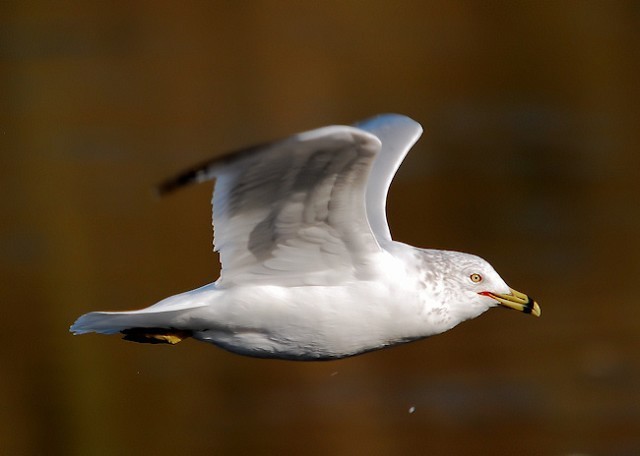
Ring-billed Gull, Cuskinny Marsh, Cork (Photo: Ronan mclaughlin)
A female Snowy Owl was seen at Dounby (Orkney) on 13th–14th; the male in Cornwall was last reported on the same date. The still-popular Black-bellied Dipper in north Norfolk was still being seen along the River Glaven this week, often at Hunworth but it did head down to Letheringsett as well. The bird was still present to 16th. The first Alpine Swift of the year was seen well but briefly over the Top Fields at Portland (Dorset) on 14th, and on 18th the first Hoopoes of spring were found on Bardsey Island (Gwynedd) and at Union Hall (Co. Cork).

Black-bellied Dipper, Hunworth, Norfolk (Photo: Chris Upson)
At least 25 Great Grey Shrikes were noted from 18 counties this week, with at least three in Hampshire and two each for Devon, Gloucestershire, Norfolk and Suffolk. At least four birds were seen in Wales. The Shore Lark remained on Shetland, at Lamba Ness, Unst to 16th.

Great Grey Shrike, Wykeham Forest, N Yorks (Photo: Colin Severs)
Around 130 Waxwings remained at Kirkby-in-Ashfield (Nottinghamshire) to 14th and the same county saw around 100 birds appear in Mansfield on the same date. A flock of 120 birds was noted at Ribbleton (Lancashire) on 13th while 100 were seen at Glasnevin (Co. Dublin) on 15th. In County Durham, 120 birds were still in Washington to 17th.

Waxwing, Preston, Lancs (Photo: Gordon Speirs)
The male Siberian Chiffchaff remained at Endon (Staffordshire) this week, with three tristis-types reported again from Holes Bay (Dorset) with further singles at Birtley (Co. Durham) on 15th and Radipole Lake (Dorset) on 18th. A Yellow-browed Warbler was seen at Bridport (Dorset) on 16th–17th. The male Penduline Tit was still being seen around Paignton (Devon) throughout the week and one was seen briefly at Rye Harbour (East Sussex) on 17th. Two Penduline Tits were reported belatedly from Minsmere (Suffolk) on 8th. A Serin was reported from Durlston CP (Dorset) on 18th.
Photo of the Week

Sparrowhawk, Kirk Ella, E Yorks (Photo:
Maurice Gordon)
With apologies to those who find explicit images of predation disturbing, we were unable to resist choosing Maurice Gordon's stunning action shot of a female Sparrowhawk and its pigeon prey. With a background in photojournalism, Maurice is obviously experienced in capturing the key moment that tells a story. Here, the story is a familiar one, but is vividly conveyed by the various elements of the image, especially the flawless posing of the two birds and the pixel-perfect cropping. The hard side-lighting emphasises the harshness of the scene. We were also delighted that Maurice added his own story of how he got the shot, including how he had the time to go home and get his camera and then use his car as a hide. A great example of making the most of a one-off opportunity!

Barn Owl, East Walton, Norfolk (Photo:
Stephen Durrant)

Coot, Stithians Reservoir, Cornwall (Photo:
Brian McGeough)

Northern Jacana, Costa Rica (Photo:
Richard Collier)

Snow Bunting, Penrhyn Bay, Conwy (Photo:
Steve Round)

Firecrest, Stanley Park, Blackpool, Lancs (Photo:
Jim Almond)
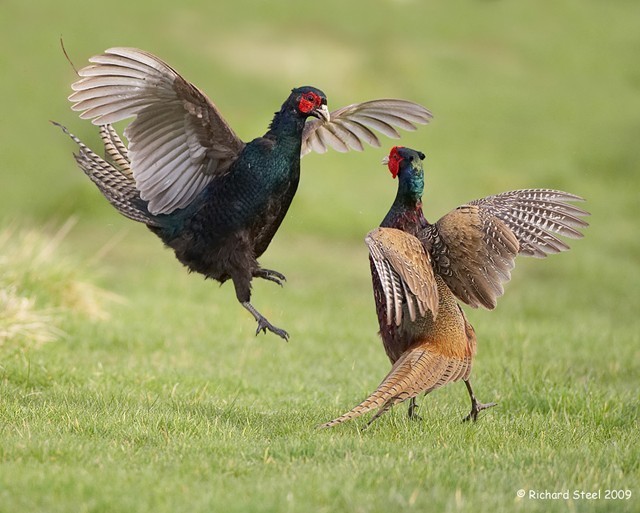
Pheasant, undisclosed site, Cheshire (Photo:
Richard Steel)

Short-eared Owl, Kinmel Bay, Conwy (Photo:
Kev Joynes)

Black-tailed Godwit, Cley Marshes NWT, Norfolk (Photo:
Nigel Pye)

Great Spotted Woodpecker, Lathkill Dale NNR, Derbys (Photo:
Robert Askew)

Red Grouse, Farndale, N Yorks (Photo:
Dave Mansell)

Ruff, Humberston Fitties, Lincs (Photo:
Matt Latham)

European Stonechat, Salthouse, Norfolk (Photo:
Jon Evans)

Siskin, Chamber's Farm Wood NR, Lincs (Photo:
Nick Clayton)

Wood Pigeon, Hythe, Kent (Photo:
Brian Harper)

